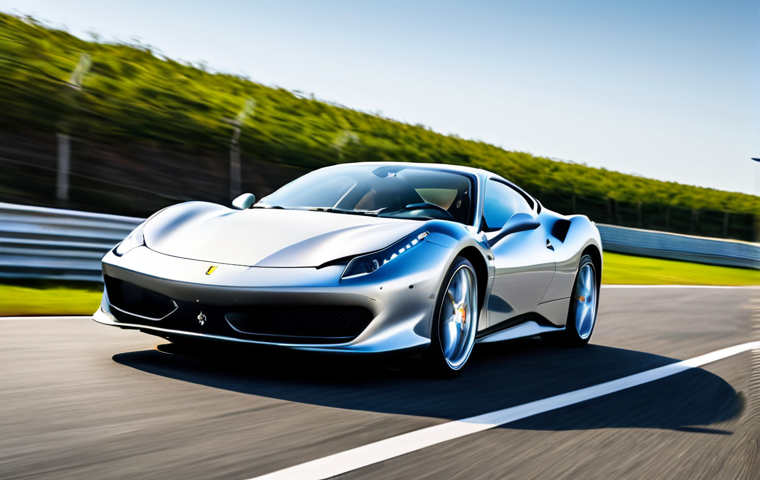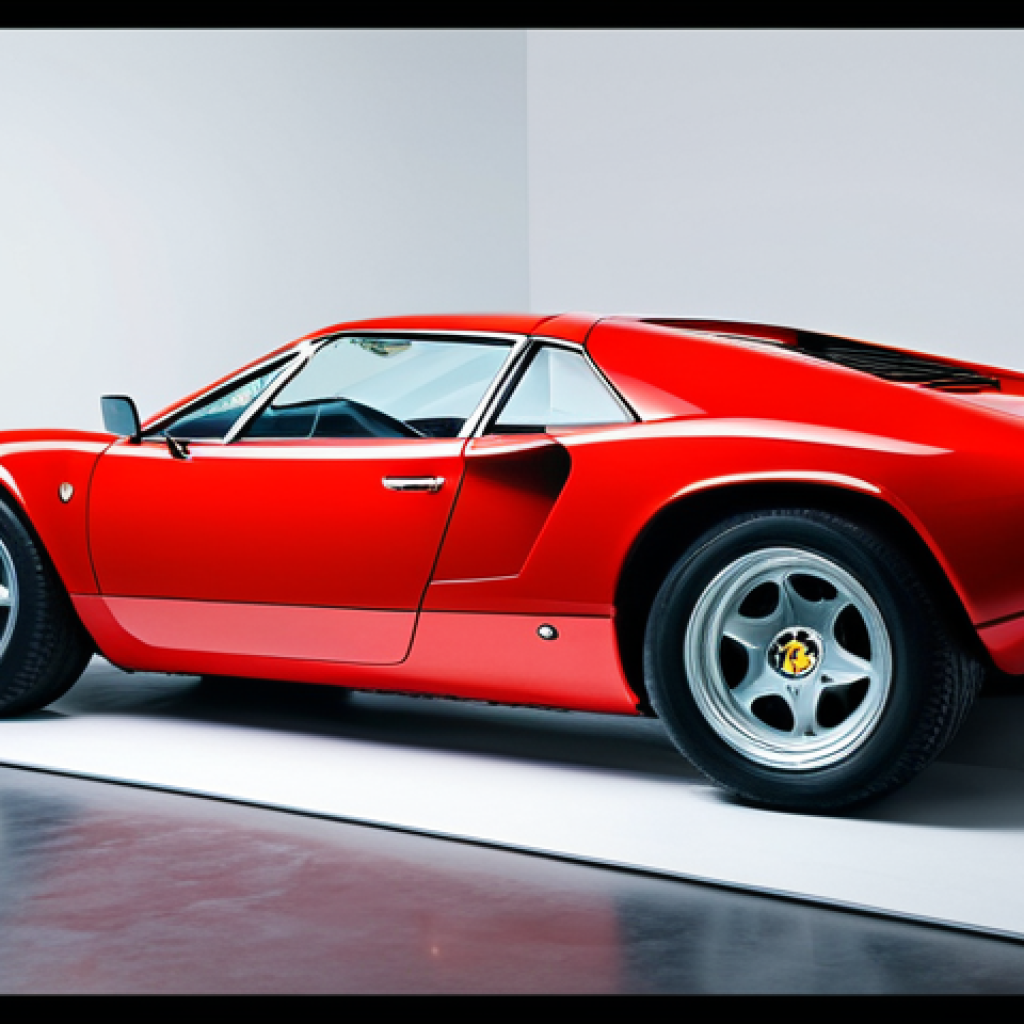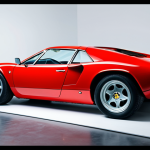Stepping into the world of Italian automotive history feels less like reading a textbook and more like being swept up in a passionate romance. I’ve always been captivated by the sheer artistry and engineering genius that defines their cars.
From the roaring engines of Modena to the sleek lines crafted in Turin, Italy hasn’t just built vehicles; they’ve sculpted moving pieces of art, embodying a spirit that’s undeniably unique.
This isn’t just about speed; it’s about soul, legacy, and an unyielding pursuit of beauty. Their journey through the decades, embracing challenges and pushing boundaries, truly sets them apart, laying the groundwork for how we perceive luxury and performance today.
Let’s explore it further below.
Stepping into the world of Italian automotive history feels less like reading a textbook and more like being swept up in a passionate romance. I’ve always been captivated by the sheer artistry and engineering genius that defines their cars.
From the roaring engines of Modena to the sleek lines crafted in Turin, Italy hasn’t just built vehicles; they’ve sculpted moving pieces of art, embodying a spirit that’s undeniably unique.
This isn’t just about speed; it’s about soul, legacy, and an unyielding pursuit of beauty. Their journey through the decades, embracing challenges and pushing boundaries, truly sets them apart, laying the groundwork for how we perceive luxury and performance today.
Let’s explore it further below.
The Roaring Heartbeat: Engineering Beyond Mechanics

When I think of Italian cars, the first thing that resonates isn’t just their speed, but that incredible, almost visceral sound. It’s an aural signature, a symphony crafted by master engineers who seemingly understood that an engine isn’t just a power source; it’s the very soul of the machine. I’ve had the privilege of hearing a Ferrari 458 Italia at full throttle, and it wasn’t just noise; it was a pure, unadulterated wail of passion, a sound that instantly sends shivers down your spine and reminds you that you’re witnessing something truly special. This isn’t just about horsepower figures on a spec sheet; it’s about how that power is delivered, how it makes you feel, and the emotional connection it forges between driver and machine. My personal belief is that Italian engineers put as much heart into the engine’s character as they do its output, tuning exhaust notes like a composer fine-tunes an orchestra. It’s a testament to their dedication that even as technology evolves, this commitment to a distinctive, emotional driving experience remains paramount.
1. The Art of Aural Mastery: Why Italian Engines Sing
There’s an undeniable magic to the sound of an Italian engine, something deeply primal and exhilarating that sets it apart. I remember the first time I heard a Lamborghini Aventador fire up; it wasn’t just a start, it was an event, a theatrical roar that promised an adventure. This isn’t accidental. It’s the result of meticulous, sometimes obsessive, engineering focused not just on mechanical efficiency but on the sensory experience. From the intricate valvetrains to the specifically tuned exhaust manifolds, every component is designed to contribute to a distinctive sonic signature. It’s about the harmonics, the blend of induction roar and exhaust blare, creating a multi-layered sound that tells a story of power, precision, and unbridled emotion. You don’t just drive an Italian car; you feel its heartbeat, its very essence communicated through sound. It’s a crucial part of the ownership experience, a daily reminder of the passion poured into its creation. They understand that a great car isn’t just about getting from A to B; it’s about the journey itself, and how every one of your senses is engaged along the way.
2. Driving with Emotion: The Tactile Connection
Beyond the auditory feast, the tactile connection in an Italian car is something truly unique. I’ve found that the steering feel, the feedback through the pedals, and even the way the gearbox engages, all contribute to a sensation of direct involvement that few other marques can match. It’s as if the car is an extension of your own body, responding to every subtle input with an immediate, eager precision. This isn’t about isolated luxury; it’s about an immersive experience where you are constantly receiving feedback from the road, the engine, and the chassis. Every vibration, every shift of weight, every growl from beneath the hood feels like a direct communication from the machine to your fingertips and the seat of your pants. This unfiltered connection fosters a sense of trust and exhilarating control, a reminder that while the car is incredibly powerful, it’s also incredibly responsive and predictable when pushed. It’s this deep, almost telepathic bond that truly defines the driving experience of these remarkable vehicles.
Sculpting Speed: The Unmistakable Art of Italian Design
Italian automotive design isn’t just about aesthetics; it’s a philosophy, a way of life that has consistently pushed boundaries and defined eras. Looking at a classic Alfa Romeo or a groundbreaking Ferrari, you don’t just see a car; you see a moving sculpture, a piece of art meticulously crafted with an unwavering eye for proportion, line, and emotional impact. I remember seeing a Lamborghini Miura for the first time in person, and it felt like witnessing a glimpse into the future, even decades after its creation. The sheer audacity of its design, the sensual curves, and that distinct silhouette just scream passion. This isn’t functionalism for its own sake; it’s form following an artistic vision, where every curve and every crease serves to evoke emotion and communicate speed even when standing still. It’s why these cars transcend mere transportation and become cultural icons, objects of desire that captivate enthusiasts and casual observers alike. My personal take is that Italian designers possess an innate understanding of human desire, translating that into tangible shapes that stir the soul. They consistently manage to blend aggressive performance cues with undeniable elegance, creating vehicles that are both beautiful and breathtakingly fast.
1. The Maestros of Metal: Iconic Design Houses
The history of Italian automotive design is intrinsically linked to legendary design houses like Pininfarina, Bertone, Italdesign Giugiaro, and Zagato. These weren’t just studios; they were creative hothouses where genius flourished, pushing the envelope of what was possible with metal and glass. My appreciation for their work deepened when I learned about the painstaking process behind each design, often involving hand-sculpted clay models and meticulous attention to detail that could only come from true masters of their craft. Each studio developed its own distinctive signature, yet all shared a common thread: an unparalleled commitment to beauty and innovation. Pininfarina, for example, became almost synonymous with Ferrari, crafting elegant, timeless shapes that embodied speed and luxury. Bertone, on the other hand, often explored more avant-garde and angular forms, creating groundbreaking designs like the Lamborghini Countach. It’s this rich tapestry of individualistic brilliance, all contributing to a collective identity of Italian design excellence, that I find so fascinating and inspiring.
2. Form Meets Emotion: The Psychology of Italian Car Shapes
There’s a profound psychological element to Italian car design that often gets overlooked. It’s not just about making a car look “good”; it’s about making it feel exciting, desirable, and even a little dangerous. When I look at the aggressive stance of a modern Maserati or the sinuous lines of an older Alfa Romeo, I feel a rush of adrenaline, an urge to get behind the wheel and experience that promised thrill. This emotional connection is deliberately engineered into the car’s very form. Designers utilize visual cues like low slung profiles to suggest speed, prominent grilles to convey power, and sweeping lines that imply dynamism and movement. The interplay of light and shadow on their sculpted surfaces creates a visual drama that constantly shifts as you move around the car. It’s an almost theatrical presentation, where the car itself is the star of the show. This mastery of visual storytelling is why Italian cars often feel more alive, more charismatic, and more emotionally resonant than their counterparts from other nations. They’re not just machines; they’re passionate declarations.
From Racetrack Legends to Road Royalty: Performance Heritage
The heart of Italian motoring beats fiercely on the racetrack. It’s where legends are born, where engineering is pushed to its absolute limits, and where the raw, unadulterated spirit of competition truly shines. I’ve always been captivated by the deep-rooted connection between Italian road cars and their racing counterparts. It’s not just a marketing slogan; it’s a fundamental part of their DNA. Think of Ferrari’s storied history in Formula 1, or Lamborghini’s audacious challenge to create the fastest supercars. This isn’t just about winning races; it’s about using the unforgiving crucible of motorsport to hone technology, refine design, and ultimately, inject that competitive edge directly into the vehicles we can actually buy. My experience driving a high-performance Italian car on a track day felt less like a drive and more like a dance with a finely tuned athlete, a direct descendant of those very racing machines. The precision, the immediate throttle response, and the sheer grip are all testaments to decades of relentless pursuit of victory on the world’s most challenging circuits. It’s a heritage that truly sets them apart, giving every model a palpable sense of racing pedigree.
1. The Grand Prix Legacy: Birthplace of Automotive Heroes
Italy’s contribution to Grand Prix racing, particularly through Ferrari, is monumental. Enzo Ferrari’s relentless pursuit of perfection on the track cemented the brand’s reputation and, in my view, shaped the entire landscape of high-performance motoring. The innovations, the rivalries, the sheer drama of those early races – it all contributed to a mystique that persists to this day. I often find myself watching old race footage, mesmerized by the bravery of the drivers and the raw power of the machines. These aren’t just historical events; they are foundational stories that explain why a Ferrari or an Alfa Romeo feels different from anything else. The engineering lessons learned from pushing engines to their breaking point, refining aerodynamics on open-wheel cars, and developing new materials for chassis construction directly trickled down into road-going models. This symbiotic relationship between racing and production cars means that when you drive an Italian sports car, you’re not just driving a vehicle; you’re experiencing a piece of motorsport history, a lineage forged in the heat of battle and refined by countless victories and bitter defeats.
2. Road Car Reflections: Applying Track Knowledge to the Street
The transfer of technology from the racetrack to the street is a hallmark of Italian manufacturers. What’s often overlooked is not just the engine power, but the nuanced improvements in suspension geometry, brake performance, and even tire technology that originate from extreme racing conditions. I’ve noticed, for instance, how modern Ferrari and Lamborghini models, even their ‘entry-level’ ones, exhibit a level of responsiveness and stability that directly reflects their track-bred heritage. The precision steering and communicative chassis that make them so thrilling on a winding road are direct beneficiaries of lessons learned at Monza or Imola. It’s this dedication to translating motorsport excellence into tangible benefits for the everyday driver (or weekend warrior, as the case may be) that makes Italian performance cars so compelling. You’re not just buying a badge; you’re investing in a legacy of uncompromising performance engineered for the limits, yet surprisingly approachable for those who appreciate the finer points of driving dynamics. This is why their supercars feel so incredibly ‘alive’ even at moderate speeds; they constantly remind you of their incredible potential.
More Than Metal: The Cultural Fabric of Italian Motoring
Beyond the nuts and bolts, beyond the sheer speed and breathtaking design, Italian cars hold a unique place in global culture. They aren’t just vehicles; they are symbols, embodying a lifestyle, an attitude, and a certain undeniable swagger. I’ve traveled through Italy and seen firsthand how these cars are woven into the very fabric of society, from the bustling streets of Rome to the winding roads of Tuscany. It’s not uncommon to see a classic Fiat 500 parked next to a modern Ferrari, each admired for its own distinct charm. This cultural embeddedness gives Italian cars an aura that goes beyond simple luxury or performance; it speaks to heritage, passion, and an appreciation for the finer things in life. Owning one, or even just admiring one, feels like buying into a dream, a piece of that quintessential Italian spirit. From their portrayal in film and music to their prominent role in fashion and art, Italian cars transcend their mechanical purpose to become true cultural icons, objects of aspirational desire that resonate deeply with people worldwide. They evoke a sense of la dolce vita, a life lived with style, joy, and an unyielding pursuit of beauty in all its forms.
1. The La Dolce Vita Effect: Italian Cars in Pop Culture
I find it absolutely fascinating how deeply Italian cars have permeated pop culture, becoming almost shorthand for luxury, speed, and sophistication. Think of James Bond tearing through city streets in an Aston Martin (often chasing or being chased by an Italian car!), or the iconic red Ferrari in “Magnum, P.I.” – these vehicles weren’t just props; they were characters in their own right, embodying the essence of their respective heroes and villains. This cultural omnipresence isn’t accidental; it’s a reflection of their inherent charisma and visual drama. They are cinematic, photogenic, and instantly recognizable symbols of aspiration and success. Even in music, from classic rock anthems to modern pop tracks, the mention of a Lamborghini or a Maserati instantly conjures images of opulence and exhilaration. My theory is that their distinct designs and visceral sounds make them unforgettable, etching them into our collective consciousness as emblems of the good life, of adventure, and of uncompromising style. They don’t just move people; they move culture itself.
2. Brands as Beacons: Identity and Aspiration
For me, Italian car brands aren’t just companies; they’re almost like family dynasties, each with its own distinct personality and unwavering legion of devoted followers. Ferrari evokes unparalleled racing pedigree and exclusivity. Lamborghini screams audacious design and rebellious power. Maserati whispers understated elegance and luxurious performance. Alfa Romeo, meanwhile, tugs at the heartstrings with its beautiful, driver-focused machines, often seen as a connoisseur’s choice. What fascinates me is how these brands cultivate such fierce loyalty and aspiration. Owning one isn’t just about having a car; it’s about identifying with a particular ethos, joining an exclusive club, and making a statement about who you are and what you value. This emotional branding is incredibly powerful, transforming a purchase into an experience, a dream fulfilled. The storied histories, the iconic models, and the consistent pursuit of excellence have built a formidable reputation that transcends mere marketing. It’s a deep-seated connection to a brand narrative that feels almost personal, a testament to the power of passion in manufacturing.
Navigating the Curves of Time: Enduring Innovation and Evolution
The Italian automotive industry hasn’t merely existed for decades; it has consistently innovated, adapted, and pushed the boundaries of what’s possible, much like a skilled driver navigating a challenging mountain pass. I’ve watched with keen interest as Italian manufacturers, historically rooted in traditional internal combustion engines, embrace the future of mobility with surprising agility and a characteristic flair. From early aerodynamic breakthroughs to the integration of cutting-edge hybrid and electric powertrains, the spirit of innovation remains fiercely alive. It’s not just about keeping up with the times; it’s about leading the charge, finding uniquely Italian solutions to global challenges. My take is that while many might associate Italian cars primarily with their glorious past, the industry is incredibly forward-thinking, constantly seeking to combine their emotional heritage with sustainable technologies. This continuous evolution demonstrates a resilience and a commitment to excellence that ensures their relevance in an ever-changing automotive landscape. They aren’t afraid to experiment, to innovate, and to redefine what a high-performance, luxurious vehicle can be in the modern era.
1. From Carburetors to Capacitors: The Electrification Journey
The shift towards electrification might seem counter-intuitive for brands built on the roar of V12 engines, but Italian marques are embracing it with typical boldness. I’ve been particularly impressed by how they’re approaching hybridization and full EVs, not as a compromise, but as an opportunity to enhance performance and redefine the driving experience. Ferrari’s SF90 Stradale, for instance, isn’t just a hybrid; it’s an incredibly potent hypercar that uses electric motors to boost acceleration and control in ways previously unimaginable. Lamborghini’s Sián FKP 37, with its supercapacitor technology, offers a glimpse into a future where instantaneous power delivery is taken to new extremes. It’s clear they are not simply slapping batteries into existing platforms; they are engineering from the ground up, integrating these new technologies to amplify their core values of performance and emotion. This isn’t a departure from their soul; it’s an evolution, a demonstration that even as the power source changes, the underlying passion for exhilarating automotive experiences remains constant. It’s inspiring to see them tackle these challenges head-on.
2. Sustainability with Style: Beyond the Tailpipe
Beyond powertrain electrification, Italian manufacturers are also increasingly focusing on broader sustainability initiatives, which I believe is crucial for their long-term appeal. This isn’t just about meeting regulations; it’s about maintaining their legacy in a world that demands environmental responsibility. I’ve seen efforts ranging from sustainable materials in interiors to more eco-friendly manufacturing processes and a reduced carbon footprint across their operations. For example, some brands are exploring innovative materials that mimic luxury while being more environmentally conscious, demonstrating that sustainability doesn’t have to mean a sacrifice in style or prestige. This comprehensive approach to environmental stewardship, which extends beyond just the tailpipe emissions, showcases a forward-thinking mindset. It’s about ensuring that the passion for beautiful cars can continue for generations to come, without compromising the planet. It’s a complex challenge, but one that Italian brands are tackling with characteristic ingenuity and a commitment to maintaining their position at the forefront of the luxury automotive world.
The Unseen Hand: Craftsmanship and Human Touch
What truly sets Italian cars apart, in my personal observation, is the profound emphasis on craftsmanship and the human touch in their creation. It’s an almost artisanal approach to manufacturing, where attention to detail isn’t just a slogan but a deeply ingrained philosophy. I’ve always felt that when you sit inside an Italian car, you’re not just in a machine; you’re enveloped in a space where skilled hands have meticulously shaped every surface, stitched every seam, and assembled every component with a precision bordering on obsession. This dedication goes far beyond automated assembly lines; it’s about the experienced eyes that scrutinize every panel gap, the trained ears that listen for the slightest imperfection in an engine note, and the expert fingers that lovingly apply the final polish. This isn’t mass production; it’s bespoke artistry on a grand scale, ensuring that each vehicle carries a unique signature of the people who brought it to life. This commitment to traditional craftsmanship, combined with cutting-edge technology, creates a product that feels truly special, possessing a soul that mass-produced alternatives often lack. It’s a testament to the enduring value of human skill in an increasingly automated world.
1. Artisanal Details: The Interior as a Masterpiece
Stepping into the cabin of a high-end Italian car is, for me, always an experience in itself, a revelation of luxurious detail and thoughtful design. It’s where the human touch truly shines, transforming a mere interior into a bespoke masterpiece. I’ve run my hand over the exquisite leather upholstery, felt the perfectly weighted click of the aluminum switchgear, and admired the intricate stitching patterns on the dashboard. These aren’t details; they’re declarations of unparalleled craftsmanship. Unlike some brands that prioritize cold, digital interfaces, Italian interiors often blend advanced technology with warm, tactile materials and ergonomically brilliant layouts. The scent of fine leather, the rich grain of carbon fiber, the gleam of polished metal – every element is carefully chosen and flawlessly executed to create an environment that is both visually stunning and profoundly comfortable. It feels tailor-made, a personal sanctuary designed to enhance the driving experience and remind you of the meticulous care poured into its creation. It’s this commitment to sensory delight that makes these cabins so utterly captivating.
2. The Bespoke Experience: Customization and Personalization
One of the most thrilling aspects of the Italian luxury car market, from my perspective, is the unparalleled level of customization and personalization available. It’s not just about picking a color from a limited palette; it’s about creating a vehicle that is truly unique to you, a direct extension of your personal taste and desires. Many manufacturers offer extensive ‘Ad Personam’ or ‘Tailor Made’ programs where clients can specify virtually every aspect of their car, from bespoke paint colors mixed exclusively for them to custom interior materials, unique stitching patterns, and even personalized engravings. I find it incredible that you can visit the factory and work directly with designers and artisans to bring your vision to life. This hands-on, collaborative process reinforces the idea that these cars are not merely products, but expressions of individuality. It’s a testament to their dedication to client satisfaction and their ability to blend industrial production with the intimacy of artisanal creation. This personal journey of creation makes the eventual ownership experience even more profound and deeply satisfying.
To illustrate the diversity and evolution of Italian automotive brands, here’s a brief overview of some key players:
| Brand | Founded | Core Philosophy/Strengths | Iconic Models | Modern Focus (Examples) |
|---|---|---|---|---|
| Ferrari | 1947 | Uncompromising performance, racing heritage, exclusivity, V12/V8 engines, emotional appeal. | 250 GTO, F40, Enzo, LaFerrari | Hybridization (SF90 Stradale, 296 GTB), electrification future, continued racing dominance. |
| Lamborghini | 1963 | Audacious design, raw power, V10/V12 engines, rebellious spirit, visual drama. | Miura, Countach, Diablo, Aventador | Hybridization (Sián, Revuelto), SUV market (Urus), exploring electrification. |
| Maserati | 1914 | Elegant luxury, sporting performance, distinctive engine note, Gran Turismo heritage. | A6GCS, Ghibli, Quattroporte, MC12 | Electrification (Folgore range), new sports cars (MC20), expanded SUV offerings. |
| Alfa Romeo | 1910 | Driving purity, beautiful design, motorsport connection, passionate ownership, accessible performance. | Giulia Sprint GT, Tipo 33 Stradale, 8C Competizione, Giulia Quadrifoglio | Performance SUVs (Stelvio), electric future, maintaining driver focus. |
| Pagani | 1992 | Hypercar exclusivity, extreme craftsmanship, bespoke artistry, obsessive attention to detail, blend of art & science. | Zonda, Huayra | Limited production, bespoke commissions, continued use of AMG engines (modified), focus on lightweight materials. |
The Price of Passion: Accessibility, Exclusivity, and the Dream
Let’s be frank: Italian performance cars often sit at the very pinnacle of automotive aspiration, carrying price tags that reflect their exclusivity, engineering prowess, and artisanal production. Yet, what I find truly fascinating is the spectrum of accessibility within the Italian automotive landscape, creating a nuanced dreamscape for enthusiasts. While the stratospheric figures of a new Ferrari or Lamborghini might seem out of reach for many, the broader Italian car culture offers different entry points, from the charm of a classic Fiat to the spirited drive of an older Alfa Romeo. This creates a powerful aspirational journey. For countless car lovers, the dream of owning an Italian masterpiece begins not with a bank transfer, but with a poster on a bedroom wall, a die-cast model, or an unforgettable encounter at a car show. It’s a dream cultivated over years, fueled by passion and admiration, transforming what might seem like a mere financial transaction into a deeply personal quest. The true value isn’t just in the monetary cost; it’s in the emotional investment, the decades of dreaming, and the unique place these cars hold in the hearts of automotive enthusiasts worldwide. This layered accessibility ensures that the Italian automotive dream, in some form, remains vibrant and alive for everyone who loves cars.
1. The Aspirational Ladder: From Fiat to Ferrari
The beauty of Italian car culture, in my experience, is its aspirational ladder, providing various rungs for enthusiasts. You might start with an affordable, charming Fiat 500, appreciating its quirky design and urban agility. From there, perhaps you dream of a more spirited Alfa Romeo, experiencing its engaging handling and passionate design. Then, for those whose careers align with their dreams, the thought turns to a Maserati, balancing luxury with performance. And finally, for a select few, the ultimate pinnacle: a Ferrari or Lamborghini, representing the zenith of automotive engineering and exclusivity. I find this journey fascinating because it’s not just about wealth; it’s about a progression of appreciation, a deepening understanding of what Italian cars represent. Each step on this ladder offers a distinct flavor of Italian motoring, allowing more people to connect with the passion, even if the ultimate supercar remains a distant, but cherished, dream. It’s this widespread accessibility of the ‘dream’ that truly sets it apart.
2. The Collectible Charm: Investing in Art on Wheels
Beyond their driving prowess, many Italian cars, particularly the classic and limited-edition models, have become highly sought-after collectibles, often seen as investments in art on wheels. I’ve personally seen how certain vintage Ferraris, Lamborghinis, and Alfa Romeos appreciate significantly in value, not just because of their rarity, but because of their enduring beauty, historical significance, and the sheer passion they embody. This isn’t just about financial gain; it’s about preserving automotive heritage, owning a tangible piece of history, and becoming a custodian of a mechanical masterpiece. The meticulous restoration process, the gatherings of like-minded collectors, and the vibrant auction scene all contribute to this unique ecosystem. For those who choose to invest in these rolling works of art, it’s a testament to the idea that true beauty and exceptional engineering have a timeless appeal, transcending fleeting trends and offering a profound sense of pride and connection to a rich automotive legacy. It’s a testament to their enduring appeal that they are cherished not just for their performance, but for their intrinsic artistic value.
Wrapping Up
As we bring our journey through the heart of Italian automotive excellence to a close, what truly resonates isn’t just the roar of an engine or the curve of a fender, but the profound human passion woven into every stitch and every component. Italian cars are more than just machines; they are living testaments to artistry, engineering brilliance, and an unyielding pursuit of beauty and emotion. My own experiences, whether hearing a legendary engine note or simply gazing at a timeless design, reaffirm that these vehicles aren’t just driven; they are felt, experienced, and cherished. They offer a unique blend of heritage and innovation, proving that the soul of motoring can indeed be sculpted from metal and passion, leaving an indelible mark on all who encounter them.
Good to Know
If you’re truly captivated by the world of Italian cars, here are a few insights I’ve gathered:
1. Visit the Holy Grails: Make a pilgrimage to Italy’s “Motor Valley” in Emilia-Romagna. Museums like Museo Ferrari in Maranello, Museo Lamborghini in Sant’Agata Bolognese, and Museo Horacio Pagani are absolutely essential to truly grasp the history and passion firsthand. They offer an immersive experience that photos simply can’t capture.
2. Join the Community: The global Italian car enthusiast community is incredibly vibrant and welcoming. Joining local clubs or online forums can offer unparalleled access to knowledge, events, and networking with fellow enthusiasts. Sharing experiences and learning from others who share your passion significantly enhances the ownership or appreciation journey.
3. Understand the Investment: While exhilarating, owning a performance Italian car, especially a classic, often comes with specialized maintenance requirements. Factor in the cost and find reputable specialists who understand these unique machines. It’s a commitment, but one that many find incredibly rewarding.
4. Attend a Concours d’Elegance: To see some of the most stunning and rare Italian cars in pristine condition, seek out prestigious events like the Concorso d’Eleganza Villa d’Este or Pebble Beach Concours d’Elegance. These gatherings are a feast for the eyes and a chance to witness automotive history on display.
5. Consider a Driving Experience: If ownership is a distant dream, consider booking a driving experience in Italy or at a specialized track. Getting behind the wheel of a Ferrari or Lamborghini, even for a short time, provides an unforgettable taste of their power and emotion, solidifying why they are so revered.
Key Takeaways
Italian automobiles transcend mere transportation, embodying a unique blend of passionate engineering, iconic design, and a profound emotional connection.
Their roaring engines are masterfully tuned symphonies, and their sculpted forms are moving works of art that evoke speed and desire. Rooted deeply in a rich racing heritage, this track-bred excellence directly translates into the tactile, exhilarating driving experience of their road cars.
Beyond mechanics, Italian cars are cultural icons, symbols of “la dolce vita” and aspirational dreams, from charming classics to exclusive hypercars. Despite their storied past, the industry is boldly innovating with electrification and sustainable practices, all while preserving the irreplaceable human touch and artisanal craftsmanship that define their bespoke nature and enduring appeal.
Frequently Asked Questions (FAQ) 📖
Q: What is it about Italian automotive design that just grabs you, that makes it feel so much more than just metal and mechanics?
A: Honestly, for me, it’s that raw, unashamed emotionality they bake into every curve and every line. It’s not about cold, calculated aerodynamics; it’s about pure, unadulterated passion.
I remember standing next to a classic Ferrari 250 GTO once, and I literally gasped. It wasn’t just beautiful; it was alive. They design from the heart, crafting a visual symphony that stirs something deep inside you.
It’s why an Alfa Romeo, even a humble one, can feel so much more special than something with similar specs from elsewhere. It’s that indescribable soul that pours out of their workshops in Modena or Turin – a daring pursuit of beauty that often challenges convention.
Q: So, if we’re talking about the ‘soul’ and ‘legacy,’ which places or brands truly embody that quintessential Italian automotive spirit? Where does this magic truly come alive?
A: Oh, this is where it gets really fun! When I think ‘Italian automotive soul,’ my mind immediately goes to a few legendary spots. Modena, for instance – that’s the heart of it all.
You can practically feel the roar of a Ferrari or a Lamborghini in the air there. That’s where you find the unbridled, almost audacious passion of brands like Ferrari, Lamborghini, and Maserati, each with its own distinct flavor but all sharing that fierce desire for performance and drama.
Then you have Turin, a city that might seem more industrial, but it’s where giants like Fiat and Alfa Romeo really cemented their legacies, particularly in shaping the broader automotive landscape.
It’s like different chapters of a passionate love story, each with its unique characters, yet all bound by that shared pursuit of engineering and aesthetic brilliance.
Q: Given all this history and passion, how do you think this distinctly Italian approach to car-making has fundamentally reshaped our ideas of luxury and performance in the automotive world today?
A: It’s profound, really. Italy didn’t just build faster cars; they redefined what ‘performance’ and ‘luxury’ even meant. Before them, speed was often just about raw power.
But Italian marques infused it with artistry, sensuality, and an experience that went beyond the numbers. My first time in a high-performance Italian car, it wasn’t just the speed that took my breath away; it was the way the leather smelled, the sculpted dashboard, the sound that echoed in your chest.
They taught the world that a car could be a living, breathing extension of emotion, a status symbol, yes, but also a deeply personal statement. They dared to blend opera with engineering, and in doing so, they laid down the blueprint for every supercar, every luxury GT that followed, pushing boundaries not just in terms of horsepower, but in pure, undeniable presence and feeling.
That’s their enduring legacy, and frankly, I think it’s pure magic.
📚 References
Wikipedia Encyclopedia
구글 검색 결과
구글 검색 결과
구글 검색 결과
구글 검색 결과




